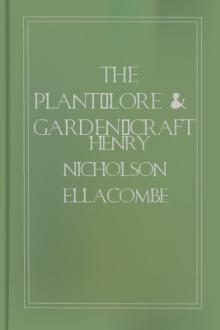The plant-lore & garden-craft of Shakespear, Henry Nicholson Ellacombe [read with me .TXT] 📗

- Author: Henry Nicholson Ellacombe
- Performer: -
Book online «The plant-lore & garden-craft of Shakespear, Henry Nicholson Ellacombe [read with me .TXT] 📗». Author Henry Nicholson Ellacombe
The two properties of the Marigold—that it was always in flower, and that it turned its flowers to the sun and followed his guidance in their opening and shutting—made it a very favourite flower with the poets and emblem writers. T. Forster, in the "Circle of the Seasons," 1828, says that "this plant received the name of Calendula, because it was in flower on the calends of nearly every month. It has been called Marigold for a similar reason, being more or less in blow at the times of all the festivals of the Blessed Virgin Mary, the word gold having reference to its golden rays, likened to the rays of light around the head of the Blessed Virgin." This is ingenious, and, as he adds, "thus say the old writers," it is worth quoting, though he does not say what old writer gave this derivation, which I am very sure is not the true one. The old name is simply goldes. Gower, describing the burning of Leucothoe, says—
Into a flour, was named Golde,
Which stant governed of the Sonne."
Conf. Aman., lib. quint.
Chaucer spoke of the "yellow Goldes;"[157:1] in the "Promptorium Parvulorum" we have "Goolde, herbe, solsequium, quia sequitur solem, elitropium, calendula;" and Spenser says—
I would her liken to a crowne of Lillies,
Upon a virgin brydes adorned head,
With Roses dight and Goolds and Daffodillies."
Colin Clout.
But it was its other quality of opening or shutting its flowers at the sun's bidding that made the Marigold such a favourite with the old writers, especially those who wrote on religious emblems. It was to them the emblem of constancy in affection,[157:2] and sympathy in joy and sorrow, though it was also the emblem of the fawning courtier, who can only shine when everything is bright. As the emblem of constancy, it was to the old writers what the Sunflower was to Moore—
The same look which she did when he rose."
It was the Heliotrope or Solsequium or Turnesol of our forefathers, and is the flower often alluded to under that name.[158:1] "All yellow flowers," says St. Francis de Sales, "and, above all, those that the Greeks call Heliotrope, and we call Sunflower, not only rejoice at the sight of the sun, but follow with loving fidelity the attraction of its rays, gazing at the sun, and turning towards it from its rising to its setting" ("Divine Love," Mulholland's translation).
Of this higher and more religious use of the emblematic flower there are frequent examples. I will only give one from G. Withers, a contemporary of Shakespeare's later life—
The grateful and obsequious Marigold,
How duly every morning she displays
Her open breast when Phœbus spreads his rays;
How she observes him in his daily walk,
Still bending towards him her small slender stalk;
How when he down declines she droops and mourns,
Bedewed, as 'twere, with tears till he returns;
And how she veils her flowers when he is gone.
When this I meditate, methinks the flowers
Have spirits far more generous than ours,
And give us fair examples to despise
The servile fawnings and idolatries
Wherewith we court these earthly things below,
Which merit not the service we bestow."
From the time of Withers the poets treated the Marigold very much as the gardeners did—they passed it by altogether as beneath their notice.
FOOTNOTES:[157:1]
The Knightes Tale.
[157:2]
She to you the Marigold,
To none but you her leaves unfold."
Middleton and Rowley, The Spanish Gipsy.
See also Thynne's "Emblems," No. 18; and Cutwode's "Caltha Poetarum," 1599, st. 18, 19.
[158:1] "Solsequium vel heliotropium; Solsece vel sigel-hwerfe" (i.e., sun-seeker or sun-turner).—Ælfric's Vocabulary.
In a note Mr. Herttage says, "the oldest name for the plant was ymbglidegold, that which moves round with the sun."
MARJORAM. (1) Perdita. Here's flowers for you;Hot Lavender, Mints, Savory, Marjoram. Winter's Tale, act iv, sc. 4 (103). (2) Lear. Give the word. Edgar. Sweet Marjoram. Lear. Pass. King Lear, act iv, sc. 6 (93). (3) The Lily I condemned for thy hand,
And buds of Marjoram had stolen thy hair. Sonnet xcix. (4) Clown. Indeed, sir, she was the sweet Marjoram of the Salad, or rather the Herb-of-grace. All's Well that Ends Well, act iv, sc. 5 (17).
In Shakespeare's time several species of Marjoram were grown, especially the Common Marjoram (Origanum vulgare), a British plant, the Sweet Marjoram (O. Marjorana), a plant of the South of Europe, from which the English name comes,[159:1] and the Winter Marjoram (O. Horacleoticum). They were all favourite pot herbs, so that Lyte calls the common one "a delicate and tender herb," "a noble and odoriferous plant;" but, like so many of the old herbs, they have now fallen into disrepute. The comparison of a man's hair to the buds of Marjoram is not very intelligible, but probably it was a way of saying that the hair was golden.
FOOTNOTES:[159:1] See "Catholicon Anglicum," s.v. Marioron and note.
MARYBUDS, see Marigold. MAST. Timon. The Oaks bear Mast, the Briers scarlet hips. Timon of Athens, act iv, sc. 3 (174).We still call the fruit of beech, beech-masts, but do not apply the name to the acorn. It originally meant food used for fatting, especially for fatting swine. See note in "Promptorium Parvulorum," p. 329, giving several instances of this use, and Strattmann, s.v. Mæst.
MEDLAR. (1) Apemantus. There's a Medlar for thee, eat it. Timon. On what I hate I feed not. Apemantus. Dost hate a Medlar? Timon. Ay, though it looks like thee. Apemantus. An thou hadst hated Meddlers sooner, thou shouldst have loved thyself better now. Timon of Athens, act iv, sc. 3 (305). (2) Lucio. They would have married me to the rotten Medlar. Measure for Measure, act iv, sc. 3 (183). (3) Touchstone. Truly the tree yields bad fruit. Rosalind. I'll graff it with you, and then I shall graff it with a Medlar; then it will be the earliest fruit in the country, for you'll be rotten ere you be half ripe, and that's the right virtue of the Medlar. As You Like It, act iii, sc. 2 (122). (4) Mercutio. Now will he sit under a Medlar tree.And wish his mistress were that kind of fruit
As maids call Medlars when they laugh alone. Romeo and Juliet, act ii, sc. 1 (80).[160:1]
The Medlar is an European tree, but not a native of England; it has, however, been so long introduced as to be now completely naturalized, and is admitted into the English flora. It is mentioned in the early vocabularies, and Chaucer gives it a very prominent place in his description of a beautiful garden—
That ever yet in alle my life I sie,
As ful of blossomes as it might be;
Therein a goldfinch leaping pretile
Fro' bough to bough, and as him list, he eet
Here and there of buddes and floweres sweet."
The Flower and the Leaf (240).
And certainly a fine Medlar tree "ful of blossomes" is a handsome ornament on any lawn. There are few deciduous trees that make better lawn trees. There is nothing stiff about the growth even from its early youth; it forms a low, irregular, picturesque tree, excellent for shade, with very handsome white flowers, followed by the curious fruit; it will not, however, do well in the North of England or Scotland.
It does not seem to have been a favourite fruit with our forefathers. Bullein says "the fruite called the Medler is used for a medicine and not for meate;" and Shakespeare only used the common language of his time when he described the Medlar as only fit to be eaten when rotten. Chaucer said just the same—
Till it be rote in mullok or in stree—
We olde men, I drede, so fare we,
Till we be roten, can we not be rype."
The Reeves Tale.
And many others writers to the same effect. But, in fact, the Medlar when fit to be eaten is no more rotten than a ripe Peach, Pear, or Strawberry, or any other fruit which we do not eat till it has reached a certain stage of softness. There is a vast difference between a ripe and a rotten Medlar, though it would puzzle many of us to say when a fruit (not a Medlar only) is ripe, that is, fit to be eaten. These things are matters of taste and fashion, and it is rather surprising to find that we are accused, and by good judges, of eating Peaches when rotten rather than ripe. "The Japanese always eat their Peaches in an unripe state. In the 'Gartenflora' Dr. Regel says, in some remarks on Japanese fruit trees, that the Japanese regard a ripe Peach as rotten."
There are a few varieties of the Medlar, differing in the size and flavour of the fruits, which were also cultivated in Shakespeare's time.
FOOTNOTES:[160:1] So Chester speaks of it as "the Young Man's Medlar" ("Love's Martyr," p. 96, New Sh. Soc.).
MINTS.




Comments (0)